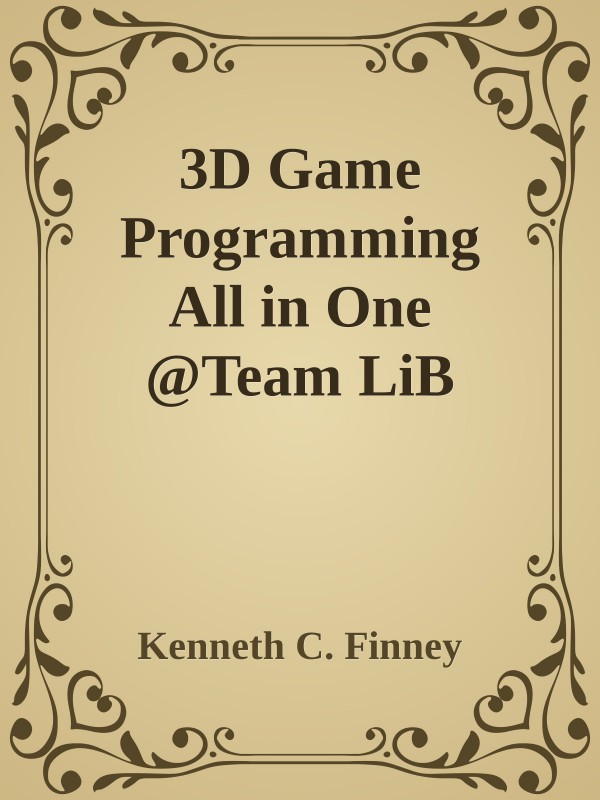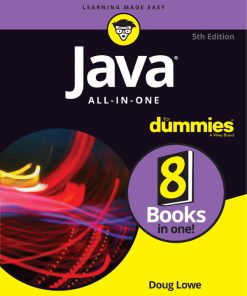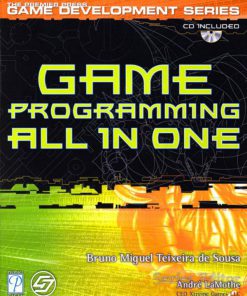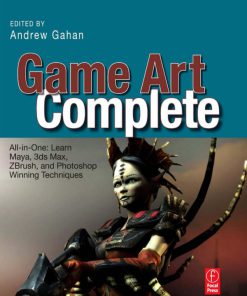3D Game Programming All in One 1st Edition by Kenneth Finney ISBN 159200136X 9781592001361
$50.00 Original price was: $50.00.$25.00Current price is: $25.00.
Authors:Kenneth C. Finney , Series:Gaming [101] , Author sort:Finney, Kenneth C. , Ids:159200136X , Languages:Languages:eng , Publisher:Course Technology , Comments:Comments:Published 2004, 812 pages.
3D Game Programming All in One 1st Edition by Kenneth Finney – Ebook PDF Instant Download/Delivery. 159200136X ,9781592001361
Full download 3D Game Programming All in One 1st Edition after payment
Product details:
ISBN 10: 159200136X
ISBN 13: 9781592001361
Author: Kenneth Finney
3D Game Programming All in One 1st Edition Table of contents:
Chapter 1: Introduction to Game Programming
- The Basics of Game Development
- Understanding Game Loops and Game Engines
- Overview of the Game Development Process
- Setting Up Your Development Environment
- Introduction to 3D Math: Vectors and Matrices
- Basic Concepts of 3D Graphics
Chapter 2: The Basics of 3D Math
- 3D Coordinate Systems and Transformations
- Vectors: Operations and Applications in 3D Space
- Matrices and Their Role in 3D Transformations
- Dot Product, Cross Product, and Their Uses in Graphics
- Rotation, Translation, and Scaling in 3D
- Quaternions and Their Advantages in 3D Graphics
- Example: Basic 3D Movement and Transformation Code
Chapter 3: Understanding 3D Rendering
- What is 3D Rendering?
- The Rendering Pipeline: From Model to Screen
- How 3D Models are Represented and Stored
- The Role of Shaders in Rendering
- Working with Vertices, Textures, and Materials
- How Lights and Shadows Affect the Scene
- Basic Lighting Models in 3D Graphics
- Example: Rendering a Simple 3D Object
Chapter 4: Working with 3D Models
- Creating and Importing 3D Models for Games
- File Formats for 3D Models: .OBJ, .FBX, and .3DS
- Using Tools for 3D Modeling (Blender, Maya, etc.)
- Skeletal Animation and Rigging
- Texture Mapping: Applying Textures to 3D Models
- Creating Normal and Bump Maps for Realism
- Example: Importing and Displaying a 3D Model in a Game Engine
Chapter 5: Camera and View Control
- The Camera in 3D Space: Understanding Views and Projections
- Types of Cameras: First-Person, Third-Person, and Free-Flying
- Camera Transformations and Movement
- Implementing a Basic First-Person Shooter Camera
- Using Viewports and Clipping Planes
- Field of View, Near and Far Clipping Distances
- Example: Setting Up and Controlling a Camera
Chapter 6: 3D Animation Techniques
- Introduction to Keyframe Animation
- Working with Bones and Skeletons: Rigging Techniques
- Using Blend Shapes for Complex Character Animation
- Inverse Kinematics (IK) and Forward Kinematics (FK)
- Implementing Animation Controllers in a Game Engine
- Handling Character Animation and Interpolation
- Example: Animating a Character in a Game
Chapter 7: Collision Detection and Physics
- The Importance of Collision Detection in Games
- AABB, OBB, and Sphere-Based Collision Detection
- Handling Collisions Between Static and Dynamic Objects
- Introduction to Physics Engines: Gravity, Forces, and Rigid Bodies
- Implementing Physics in 3D Game Engines
- Realistic Movement and Collision Response
- Example: Implementing Simple Physics and Collision Detection
Chapter 8: Game AI and Pathfinding
- Basics of AI in 3D Games
- Decision-Making in Non-Player Characters (NPCs)
- Pathfinding Algorithms: A* and Navigation Meshes
- Steering Behaviors for NPC Movement
- Implementing Flocking and Group Behaviors
- Using AI to Enhance Player Interactions in 3D Worlds
- Example: Creating an AI Character that Navigates a 3D World
Chapter 9: Shaders and Visual Effects
- Introduction to Shaders: Vertex and Fragment Shaders
- Writing Your First Shader in GLSL or HLSL
- Understanding the Role of Shaders in the Rendering Pipeline
- Implementing Basic Lighting Shaders
- Post-Processing Effects: Bloom, Motion Blur, and Depth of Field
- Advanced Effects: Particle Systems, Reflection, and Refraction
- Example: Creating a Shader for a Water Surface
Chapter 10: Creating 3D Game Worlds
- World Building: Design and Conceptualization
- Terrain Generation and Texturing
- Procedural Generation of Landscapes and Objects
- Creating Realistic Environments: Trees, Water, and Rocks
- Handling Large Worlds and Level Streaming
- Adding Interactive Elements to Your World
- Example: Creating a 3D Open-World Terrain
Chapter 11: Multiplayer and Networking in 3D Games
- Basics of Multiplayer Game Development
- Networking Concepts: Latency, Bandwidth, and Client-Server Models
- Synchronizing 3D Objects in a Networked Environment
- Handling Networked Player Movement and Actions
- Dealing with Lag and Predictive Techniques
- Using Networking Libraries and Tools
- Example: Implementing a Simple Multiplayer Game in 3D
Chapter 12: Optimizing 3D Games for Performance
- Identifying Performance Bottlenecks in 3D Games
- Techniques for Optimizing Rendering Performance: Culling, Level of Detail (LOD)
- Managing Memory and Texture Usage
- Using Occlusion Culling and Frustum Culling for Efficiency
- Optimizing Physics Calculations and AI Processes
- Multithreading and Parallel Processing for 3D Games
- Example: Optimizing a Complex 3D Scene for Real-Time Rendering
Chapter 13: Sound and Music in 3D Games
- The Role of Sound in Enhancing Game Worlds
- 3D Sound Localization: Creating Realistic Soundscapes
- Implementing Spatial Audio and Environmental Sounds
- Using Background Music and Sound Effects
- Sound Libraries and APIs for Game Developers
- Example: Adding Sound Effects and Music to a 3D Game
Chapter 14: Bringing It All Together
- Integrating All Components: Models, Animation, AI, and Physics
- Debugging and Testing Your 3D Game
- Building and Publishing a 3D Game
- Packaging and Distributing Your Game
- Monetizing and Marketing Your Game
- Example: Completing a Simple 3D Game
People also search for 3D Game Programming All in One 1st Edition:
advanced 3d game programming all in one pdf
3d game programming all in one pdf
3d game programming all in one third edition
game programming in c++ creating 3d games
You may also like…
eBook PDF
Excel 2013 All in One For Dummies 1st Edition by Greg Harvey ISBN 1118510100 9781118510100
eBook EPUB
Excel 2019 All in One For Dummies 1st Edition by Greg Harvey ISBN 1119518210 9781119518211
eBook PDF
Excel 2010 All in One For Dummies 1st Edition by Greg Harvey ISBN 0470489596 9780470489598












